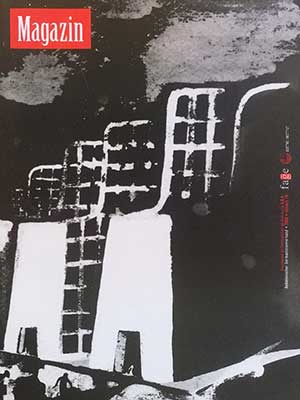La adquisición del parámetro del ascenso verbal en el alemán como tercera lengua
DOI:
https://doi.org/10.12795/mAGAzin.2008.i18.04Abstract
Sin resumenDownloads
References
A Commemorative Volume, Santiago de Compostela, Universidad de Santiago de Compostela, pp. 389-397.
(2004/2005), «La hipótesis de la transferencia de la L2 y la adquisición del orden de pala- bras», Revista Española de Lingüística Apli- cada, 17/18, 187-208.
(2005), El papel de la segunda lengua en la ad- quisición del orden de palabras del alemán como tercera lengua, Tesis doctoral, Univer- sidad del País Vasco/Euskal Herriko Unibert- sitatea, Vitoria-Gasteiz.
(2006), «Syntactic optionality in L2 grammars»,
Interlingüística, [en prensa].
Meisel, J. (1983), «Transfer as a second lan- guage strategy», Language and Communi- cation 3 (1), 11-46.
Meisel, J. (1997), «The acquisition of the syntax of negation in French and German: Con- trasting first and second language deve- lopment», Second Language Research, 13, 227-263.
Möhle, D. (1989), «Multilingual interaction in foreign language production», en H. W. Der- chert y M. Raupach, pp. 179-194.
Neuner, G. (1996), «Deutsch als zweite Fremds- prache nach Englisch. Überlegungen zur Di- daktik und Methodik und zur Lehrmateria- lentwicklung für die ‘Drittsprache Deutsch’», Deutsch als Fremdsprache, 4, 211-217.
Pica, T. (2002), «Subject-matter content: How does it assist the interactional and linguistic needs of classroom language learning?», The Modern Language Journal, 86 (1), 1-19.
Platzack, C. (1996), «The initial hypothesis of syntax: A Minimalist perspective on lan- guage acquisition and attrition», en H. Clahsen, Generative Perspectives on Lan- guage Acquisition, Amsterdam, John Ben- jamins, 396-414.
Prévost, P. y L. White. (2000), «Missing surfa- ce inflection or impairment in Second Lan- guage Acquisition? Evidence from tense and agreement», Second Language Research, 16, 2, 103-133.
Ringbom, H. (1983), «Borrowing and lexi- cal transfer», Applied Linguistics, 4 (3),
-12.
(1987), The Role of the First Language in Fo- reign Language Learning, Clevedon, Multi- lingual Matters.
Robertson, D. y A. Sorace. (1999), «Losing the V2 constraint», en E. C. Klein y G. Marto- hardjono, The Development of Second Lan- guage Grammars, Amsterdam, John Benja- mins, 317-367.
Schwartz, B. D. y R. Sprouse. (1994), «Word or- der and nominative case in nonnative langua- ge acquisition: A longitudinal study of (L1 Tur- kish) German Interlanguage», en T. Hoekstra y B. F. Schwartz, Language Acquisition Stu- dies in Generative Grammar, pp. 317-368.
(1996), «L2 cognitive states and the Full Transfer/Full Access Model», Second Lan- guage Research, 12, 40-72.
Sorace, A. (2000), «Syntactic optionality in non- native grammars», Second Language Rese- arch, 16 (2), 93-102.
(2003), «Near-nativeness», en C. J. Doughty y
M. L. Long, The Handbook of Second Lan- guage Acquisition, Oxford, Blackwell, pp. 130-151.
Spada, N. (1997), «Form-Focussed instruction and second language acquisition: A review of classroom and laboratory research», Lan- guage Teaching, 30, 73-87.
Stedje, A. (1976), «Interferenz von Mutterspra- che und Zweitsprache auf eine dritte Spra- che beim freien Sprechen-ein Vergleich», Zielsprache Deutsch, 1, 15-21.
Tsimpli, I. (1997), «Resumptive strategies and L2 acquisition: A minimalist account», en BUCLD 21 Proceedings, Somerville, Casca- dilla Press, pp. 639-655.
Vainikka, A. y M. Young-Scholten. (1994),
«Direct access to X-bar theory: Evidence from Korean and Turkish adults learning German», en T. Hoekstra y B. D. Schwartz, pp. 265-316.
(1996), «Gradual development of L2 phrase structure», Second Language Research, 12, 7-39.
Vildomec, V. (1963), Multilingualism, Leyden, Syhoff.
Vogel, T. (1992), «Englisch und Deutsch gibt es immer Krieg», Zielsprache Deutsch, 23 (2), 95-99.
Welge, P. K. (1987), «Deutsch nach Englisch.
Deutsch als dritte Sprache», en S. Ehlers y
G.L. Kardener, Regionale Aspekte des Grunds- tudiums Germanistik, München, Iudicium, pp. 189-225.
White, L. (1987), «Markedness and second lan- guage acquisition. The question of transfer.», Studies in Second Language Acquisition, 9, 261-285.
Zwart, J. W. (1997a), Dutch Syntax: A Mini- malist Approach,. Dordrecht, Kluwer.
(1997b), «The Germanic SOV languages and the Universal Base Hypothesis», en L. Hae- geman, The New Comparative Syntax, Har- low, Longman, pp. 246-267.
Downloads
Published
How to Cite
Issue
Section
License
Self-archiving policy
Romeo Blue Journal (applied)
Only editor PDF can be archived
Author cannot archive the pre-print version
Author cannot archive the postprint version
- Abstract 126
- PDF (Español (España)) 57




